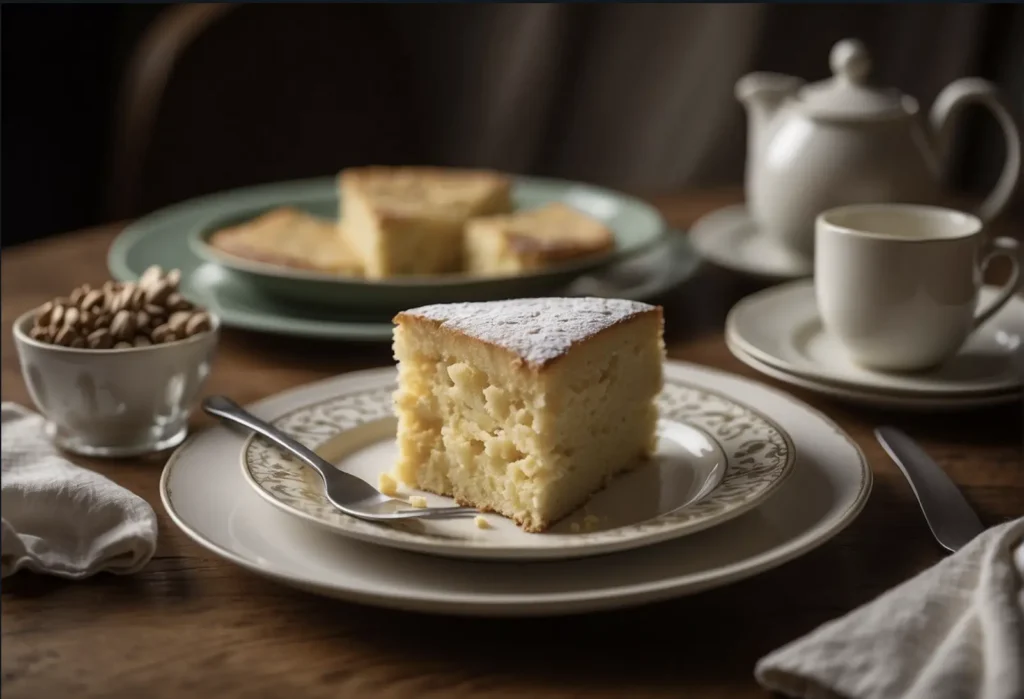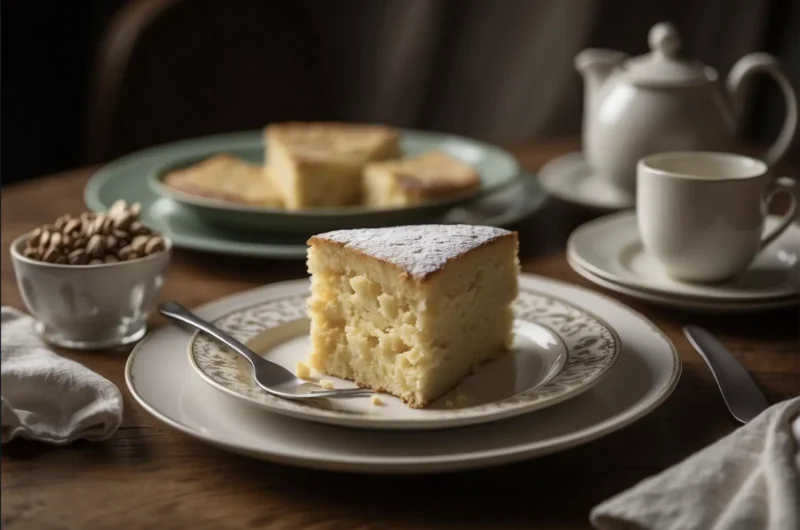I’ve always been fascinated by the rich and diverse flavors found in Guyanese cuisine, and one of its hallmark desserts is the Guyanese sponge cake. This cake is a beloved treat in Guyana, often featured at celebrations like birthdays and Christmas. Its texture is much lighter than a pound cake, yet it has a delightful richness that comes from the traditional use of butter, sugar, and eggs.

My personal experience with baking this cake has taught me that the secret to its light yet moist crumb lies in the method of creaming the butter and sugar, and gently folding in flour mixed with eggs. Some variations, like the ones prepared by my Aunty Cheryl, include multi-colored swirls and flavors which turn an everyday sponge into a festive, celebratory centerpiece.
The versatility of a Guyanese sponge cake recipe is also reflected in the added essences and zests, like vanilla or lemon and orange, giving it a distinct flavor profile that’s both refreshing and comforting. In my journey through cooking and baking, infusing the cake with these flavors and often a hint of rum, has brought a slice of Guyanese tradition into my kitchen, allowing me to savor and share a piece of my heritage.
Essential Ingredients
When I bake a Guyanese Sponge Cake, I pay close attention to the quality and measurements of the ingredients. They are the foundation of the cake’s texture and taste. Every ingredient serves a particular purpose, ensuring the final product is just as it should be: light, fluffy, and flavorful.
Flour and Leavening Agents
In my recipe, I use all-purpose flour, which provides the cake with its structure. It’s crucial not to over-measure the flour, as this will result in a dense cake. The leavening agent in this cake is typically baking powder, and it helps achieve that classic sponge cake rise. For an even rise, I ensure that my baking powder is completely evenly mixed with the flour before you add it into the wet ingredients.
Eggs and Dairy
Large eggs are central to the structure and leavening of the cake. I make sure they are at room temperature to ensure a smoother incorporation with the batter and a better rise. As for the dairy, softened butter is a must for adding richness and moisture. I cream the butter until it’s light and fluffy before gradually adding sugar.
Flavorings and Add-ins
To imbue my sponge cake with a delightful aroma, I use vanilla extract. Sometimes, I enhance the flavor further with orange zest or lemon zest; these citrus notes add a fresh depth to the cake. If I’m feeling whimsical, 3-5 drops of food coloring of my choice can give the sponge a vibrant hue, although this is optional and mostly for visual appeal.
Preparation Techniques
To create a perfect Guyanese sponge cake, precision in preparation techniques is key. I’ll guide you through creaming butter and sugar, incorporating eggs properly, and integrating dry ingredients to achieve that distinctive airy texture.
Creaming Butter and Sugar
In a large mixing bowl, I start by creaming together softened butter and sugar. This process involves beating the butter and sugar with a hand mixer at medium-high speed until the butter mixture becomes light in color and fluffy. It’s crucial for forming the base of a smooth batter and should take about 5 minutes to achieve the right consistency.
Integrating Eggs
Once the butter-sugar base is ready, I add the eggs one at a time into the butter mixture. After each egg, I ensure it’s completely incorporated before adding the next. To maintain an airy texture, I beat the mixture on low speed, so as not to deflate the mixture. Occasionally, I scrape down the sides of the bowl to ensure even mixing.
Incorporating Dry Ingredients
Lastly, I focus on the dry ingredients. In a separate bowl, I sift together the flour and other designated dry elements. This mixture, which I’ll call the flour mixture, is then gradually added to the egg mixture. It’s imperative to mix at a low speed to avoid overworking the batter. My goal here is to end up with a homogenous smooth batter without lumps, ensuring that all ingredients are just incorporated, to preserve that sought-after airy texture.
Baking and Storage
When baking a Guyanese sponge cake, the right preparation and storage methods are crucial for achieving the perfect texture and longevity. My guide will ensure your cake comes out light, fluffy, and stays fresh for your enjoyment.
Pan Preparation
I always start by preparing my cake pan to prevent the sponge cake from sticking. I either grease the baking pan generously with butter or use a cooking spray for a quick, even coat. To further ensure a seamless release, I line the bottom with parchment paper, cut to fit the pan’s shape.
Baking Process
Preheating the oven is my first step, setting it to 350°F (175°C), which is the ideal medium heat setting for the cake to rise evenly without burning. I carefully pour the batter into the prepared cake pan, spreading it to avoid air pockets that could cause uneven baking. Around 25-30 minutes later, when the top is golden and a toothpick inserted comes out clean, the cake is ready.
Cooling and Storage
Once removed from the oven, cooling is essential. I let the cake sit in the pan for a few minutes before transferring it to a wire rack. This avoids moisture buildup, keeping the bottom from getting soggy. When completely cool, I store the sponge cake in an airtight container, retaining its moisture and softness for several days.
Decoration and Serving

When I have my Guyanese sponge cake ready to be adorned and presented, I make sure to choose my decorations thoughtfully and consider the setting in which it will be served.
Frosting Options
Buttercream: For a traditional touch, I often opt for a smooth buttercream frosting. A palette knife aids in evenly spreading the frosting over the cake, ensuring a sleek finish.
Royal Icing: In cases where a firmer texture is desired, especially when intricate designs are involved, royal icing is my go-to. With the handle of a wooden spoon, I can create peaks and swirls for texture.
Serving Suggestions
Accompaniments: A scoop of ice cream or a handful of fresh fruit can elevate the simple elegance of the sponge cake. Not only do these additions provide a delightful contrast in flavors, but they also introduce a colorful visual appeal.
Presentation: After allowing the cake to cool on a wire rack, I cut it into even portions. I then arrange each slice carefully on the plate to ensure it’s as pleasant to the eye as it is to the palate.
Cultural Significance

In Guyana, sponge cake isn’t just a dessert; it’s a rich tapestry woven through our festivities and life’s special moments. I’ll explore how this cake features in traditions and its ever-evolving forms.
Traditional Celebrations
Christmas time in Guyana is synonymous with the delectable Guyanese style fruit cake and black cake, but the Guyanese sponge cake holds its own as a lighter alternative. Often hailed as a staple, it’s common to see it alongside its denser counterparts. To me, the sponge cake reminds me of the laughter and camaraderie of family gatherings, where it often stars as a cherished birthday cake or a sweet offering at other special occasions. It’s a quintessential representation of my culture, echoing the warmth of Guyanese people.
Modern Variations
While tradition is paramount, I’ve seen Guyanese sponge cake embrace modernity with impressive flavor variations. A unique twist can be anything from the inclusion of tropical fruits to the infusion of rum or mixed essence, straddling the line between the firm Guyanese pound cake and the airy sponge. These adaptations are a nod to our openness to innovation and cultural fusion, reflecting our constant evolution as a people. Flavor profiles may change, but the cake’s cultural significance remains unaltered.
Frequently Asked Questions
In this section, I address the most common queries surrounding Guyanese sponge cake, from differences in ingredients to techniques for achieving the perfect texture.
What is the difference between Guyanese sponge cake and regular sponge cake?
Guyanese sponge cake is distinct due to its light and airy texture, which is often attributed to a higher ratio of eggs to flour, setting it apart from other sponge cakes.
How can I make my sponge cake as fluffy as the Caribbean version?
To replicate the fluffy texture of a Caribbean sponge cake, it’s crucial to ensure your eggs are well-aerated, achieving this by beating them until they’re pale and voluminous, which helps to incorporate air into the batter.
What are the essential ingredients for an authentic Guyanese sponge cake?
An authentic Guyanese sponge cake typically calls for ingredients like eggs, sugar, and flour along with unique additions such as vanilla extract and citrus zest, providing its signature flavor profile.
Can you explain the steps to achieving the perfect texture in sponge cake?
Achieving the perfect texture in sponge cake involves careful mixing of well-creamed butter and sugar, followed by the gradual addition of eggs and gentle folding in of the flour to avoid deflating the airy batter.
How do butter cake and Guyanese sponge cake differ in taste and texture?
Butter cake and Guyanese sponge cake differ in that butter cakes are denser with a rich buttery flavor whereas Guyanese sponge cakes are lighter and fluffier, often showcasing a subtle hint of citrus.
What are some common variations of sponge cake found in the Caribbean?
In the Caribbean, sponge cake variations might include the addition of different flavors such as coconut, rum, or mixed spices, and visual appeals such as the incorporation of food dye, all reflecting the region’s rich culinary diversity.
Guyanese Sponge Cake
Course: DessertCuisine: GuineaDifficulty: Easy8
servings10
minutes30
minutesSoft, fluffy, and light; this sponge cake will delight your tastebuds and get you into the holiday spirit!
Ingredients
6 large eggs
1 cup granulated sugar
1 cup all-purpose flour
1 teaspoon baking powder
1 teaspoon vanilla extract
1/4 cup unsalted butter, melted and cooled
1/4 cup evaporated milk
Directions
- Preheat your oven to 350°F (175°C) and grease and flour a 9-inch round cake pan.
- In a large mixing bowl, beat the eggs and sugar together with an electric mixer until the mixture is thick, pale, and doubled in volume.
- Sift the flour and baking powder together, then gently fold them into the egg mixture using a spatula.
- Add the vanilla extract, melted butter, and evaporated milk to the batter, and gently fold them in until fully combined.
- Pour the batter into the prepared cake pan and smooth the top with a spatula.
- Bake in the preheated oven for 25-30 minutes, or until the cake is golden brown and a toothpick inserted into the center comes out clean.
- Remove the cake from the oven and let it cool in the pan for 10 minutes before transferring it to a wire rack to cool completely.

